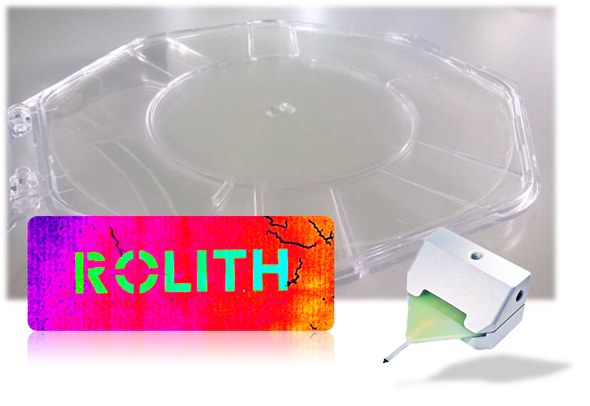Aachen/Pleasanton - Rolith, Inc. has developed a new type of security labels which are invisible to the human eye and standard equipment but can be read-out by Terahertz microprobe sensors from Protemics. Both companies are now cooperating on the development of custom-specific end-user solutions.

Figure: (Background) Photograph of the glass wafer carrying the hidden transparent label. (Bottom left) Image of the label showing the Rolith logo as measured using the Terahertz microprobe from Protemics (shown at the bottom right). The label image is formed by mapping electrical conductivity over the area revealing resistivity differences inside and outside the Logo letters.
Background
Counterfeiting presents a global economical and security problem. Fake pharmaceuticals, foods and beverages pose direct treat to the public health. Fake ID cards and passports are serious problems for governments. The drain on the global economy due to counterfeited goods and piracy will exceed $US1 trillion dollars by 2015. There is an urgent need for truly covert coding of individual items, to allow for reliable and robust authentication and tracing. This is the area where new technologies should be utilized more to assist brand owners and protect consumers.
State of the art anti-counterfeiting solutions include RFID chips, tags and labels, holograms, tamper-evident closures, special inks and nanomaterials. At present counterfeiters are able to copy most anti‐counterfeiting technologies within 18 months. A new technology which are covert and require complicated manufacturing capabilities on a nanoscale would make counterfeiting much more difficult, time consuming and expensive.
It is desirable to find ways to an secure anti-counterfeiting feature so it does not impact the overall branding and design of the product or packaging. Ideally such a solution would be a security technique that does not rely upon any feature or taggant that has to be added to an item or product. And, preferably, a non-contact technique could be used.
Hidden label on transparent material
Rolith has developed a new anti-counterfeiting technology, which is not based on optical interrogation (visual or laser-based) or tags. This new principle is based on a minute structural difference in metallic nanostructures fabricated on material surface, which are affecting electrical characteristics.
The ID/labels are invisible even on transparent materials like glass or polymer films rendering this technology very attractive for the direct integration into many products as for example smartphones, displays or watches. With this approach the first problem a potential counterfeiter has to face is to discern whether there is a security label or not because the labels cannot be visually seen or otherwise revealed using broadly available equipment. Furthermore, the technological hurdles to circumvent the security protections of this new label technology are hence extremely high. It requires special nanotechnology tools (RML® lithography) as developed by Rolith.
The contrast mechanism which is utilized for the efficient read-out of the security labels in Rolith technology is based on small sheet resistance variations. For anti-counterfeiting purposes Rolith’s trademarked NanoWeb® transparent metal mesh conductor is designed to integrate a specific Logo, code or any other useful identification and protection information into otherwise uniform conductive mesh.
The reason why it is so difficult to see the labels even with commonly used inspection tools is given by the extremely small size of structural variations on the nanometer scale which are spread over a large (mm-scale) area. Due to sub-micron features of NanoWeb structures such ID is absolutely invisible for the eye and even in inspection using regular optical microscope. To capture a full area of a label in order to extract its information using nano-analytic equipment like raster scanning electron microscopes would be extremely time consuming and difficult.
Unlocking of label information using the “Terahertz key”
Protemics has developed a new measurement technology based on advanced microprobes operating in the Terahertz frequency range which is offering world-leading performance for sheet resistance imaging in regard of measurement speed and spatial resolution. Equipped with these key features the technology qualifies as the currently most efficient solution for the read-out of the invisible labels.
Rolith and Protemics are now cooperating on the development of custom-specific end-user solutions. For example, one of the most attractive anti-counterfeiting solutions for mobile electronics would be to utilize an invisible Logo integrated into a touch screen display sensor.
REFERENCES:
Press release: http://www.prweb.com/releases/2014/09/prweb12168666.htm
Rolith, Inc.: http://www.rolith.com
MEDIA CONTACTS
Protemics GmbH
Dr. Michael Nagel
CEO
+49 241 8867 140
Rolith, Inc.
Boris Kobrin, Ph.D.
Founder and CEO
+1 925 548 6064